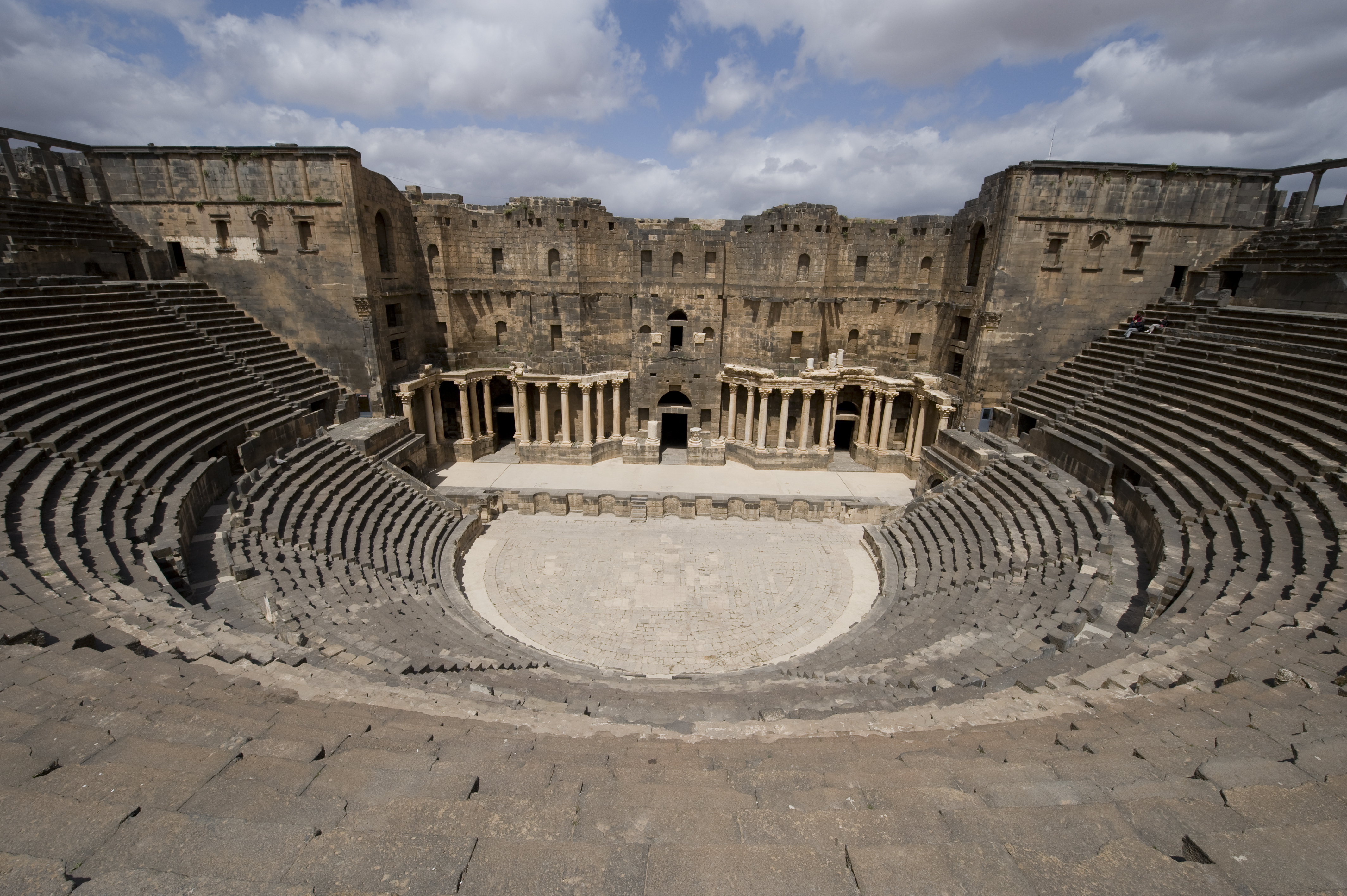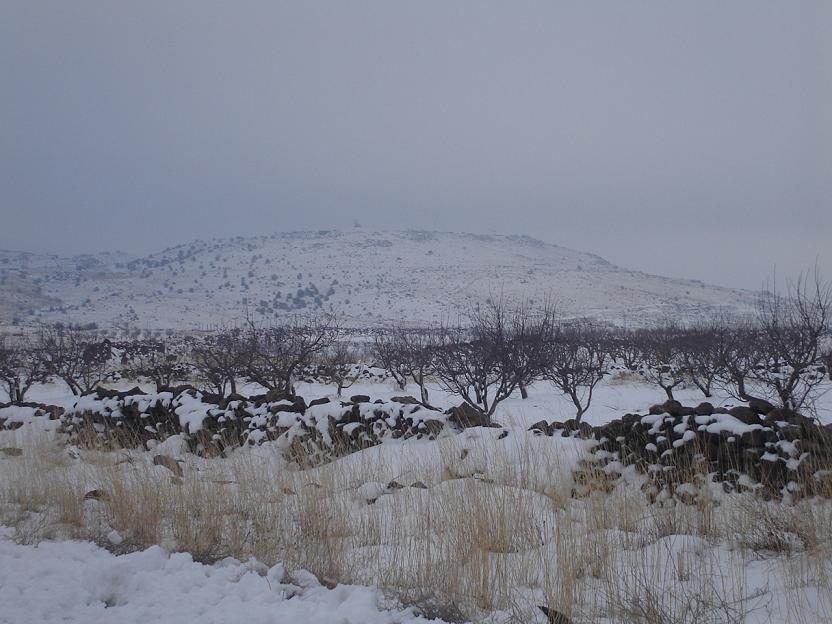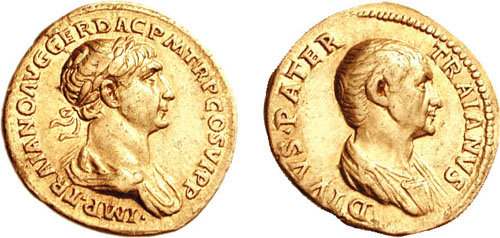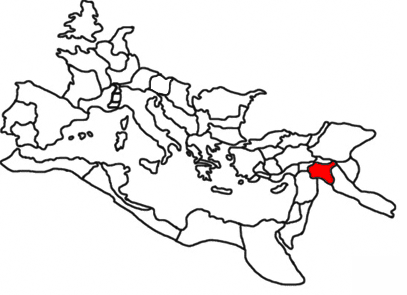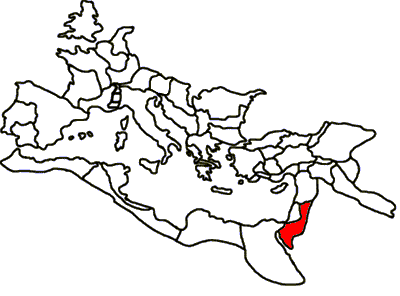|
Bosra
Bosra (), formerly Bostra () and officially called Busra al-Sham (), is a town in southern Syria, administratively belonging to the Daraa District of the Daraa Governorate and geographically part of the Hauran region. Bosra is an ancient city mentioned in 14th century BC Egyptian sources. A key Nabatean city, it became the prosperous provincial capital of the Roman province of Arabia Petraea following the dissolvement of the Nabatean kingdom. With the advent of Christianity, Bostra flourished as a Metropolitan Archbishopric, under the jurisdiction of Eastern Orthodox Patriarchate of Antioch and All the East. It also became a Latin Catholic titular see and the episcopal see of a Melkite Catholic Archeparchy. Throughout its history under various Muslim rulers, the city maintained its strategic importance as Syria's southern gateway. It attracted attention from Damascus' rulers and was governed by various lords, serving as a hub for Islamic learning and endowments. However, ... [...More Info...] [...Related Items...] OR: [Wikipedia] [Google] [Baidu] [Amazon] |
Hauran
The Hauran (; also spelled ''Hawran'' or ''Houran'') is a region that spans parts of southern Syria and northern Jordan. It is bound in the north by the Ghouta oasis, to the northeast by the al-Safa field, to the east and south by the Harrat al-Sham and to the west by the Golan Heights. Traditionally, the Hauran consists of three subregions: the Nuqrah and Jaydur plains, the Jabal al-Druze massif, and the Lajat volcanic field. The population of the Hauran is largely Arab, but religiously heterogeneous; most inhabitants of the plains are Sunni Muslims belonging to large agrarian clans, while Druze form the majority in the eponymous Jabal al-Druze and a significant Greek Orthodox and Greek Catholic minority inhabit the western foothills of Jabal al-Druze. The region's largest towns are Daraa, al-Ramtha, and al-Suwayda. From the mid-1st century BC, the region was governed by the Roman Empire's Herodian and Nabatean client kings until it was formally annexed by the empire in ... [...More Info...] [...Related Items...] OR: [Wikipedia] [Google] [Baidu] [Amazon] |
Tourism In Syria
Although Syria has some of the oldest cities in Western Asia, such as Damascus and Ancient City of Aleppo, Aleppo (a UNESCO World Heritage Site), tourism in Syria has greatly reduced as a result of the Syrian civil war, Syrian War, that began in 2011 and is ongoing, and its associated Refugees of the Syrian Civil War, refugee crisis. Tourism has been further impacted by the COVID-19 pandemic in Syria, outbreak of COVID-19 starting in March 2020. The Economic sanctions, international economic sanctions imposed on Syria and the sharp drop in the value of the Syrian pound also adversely impact tourism in Syria. The Ministry of Tourism (Syria), Ministry of Tourism is the responsible government department.Before the start of the Syrian Civil War, 8.5 million tourists visited Syria in 2010, who brought in tourist revenue estimated at Syrian pound, LS 30.8 billion (United States dollar, US$8.4 billion, at 2010 rates), and accounted for 14% of the country's economy. By 2015, ... [...More Info...] [...Related Items...] OR: [Wikipedia] [Google] [Baidu] [Amazon] |
Nabataean Kingdom
The Nabataean Kingdom (Nabataean Aramaic: 𐢕𐢃𐢋𐢈 ''Nabāṭū''), also named Nabatea () was a political state of the Nabataeans during classical antiquity. The Nabataean Kingdom controlled many of the trade routes of the region, amassing large wealth and drawing the envy of its neighbors. It stretched south along the Tihamah into the Hejaz, up as far north as Damascus, which it controlled for a short period (85–71 BC). Nabataea remained an independent political entity from the mid-3rd century BC until it was annexed in AD 106 by the Roman Empire, which renamed it to Arabia Petraea. History Nabataeans The Nabataeans were one among several formerly Bedouin, nomadic Arab tribes that roamed (later settled) the Arabian Desert and moved with their herds to wherever they could find pasture and water. They became familiar with their area as seasons passed, and they struggled to survive during bad years when seasonal rainfall diminished. The origin of the specific tribe of Arab ... [...More Info...] [...Related Items...] OR: [Wikipedia] [Google] [Baidu] [Amazon] |
Trajan
Trajan ( ; born Marcus Ulpius Traianus, 18 September 53) was a Roman emperor from AD 98 to 117, remembered as the second of the Five Good Emperors of the Nerva–Antonine dynasty. He was a philanthropic ruler and a successful soldier-emperor who presided over one of the greatest military expansions in Roman history, during which, by the time of his death, the Roman Empire reached its maximum territorial extent. He was given the title of ('the best') by the Roman Senate. Trajan was born in the of Italica in the present-day Andalusian province of province of Seville, Seville in southern Spain, an Italic peoples, Italic settlement in Hispania Baetica; his came from the town of Todi, Tuder in the Regio VI Umbria, Umbria region of central Italy. His namesake father, Marcus Ulpius Traianus (father of Trajan), Marcus Ulpius Traianus, was a general and distinguished senator. Trajan rose to prominence during the reign of Domitian; in AD 89, serving as a in , he supported t ... [...More Info...] [...Related Items...] OR: [Wikipedia] [Google] [Baidu] [Amazon] |
Daraa District
Daraa District () is a district (mantiqah) administratively belonging to Daraa Governorate, Syria. At the 2004 Census it had a population of 428,681. Its administrative centre is the city of Daraa Daraa (, Levantine Arabic: ) is a city in southwestern Syria, north of the border with Jordan. It is the capital of Daraa Governorate in the Hauran region. Located south of Damascus on the Damascus–Amman highway, it serves as a way sta .... Sub-districts The district of Daraa is divided into eight sub-districts or Nāḥiyas (population according to 2004 official census): * Daara Subdistrict (ناحية درعا): population 146,481. * Bosra Subdistrict (ناحية بصرى): population 33,839. * Khirbet Ghazaleh Subdistrict (ناحية خربة غزالة): population 44,266. * Al-Shajara Subdistrict (ناحية الشجرة): population 34,206. * Da'el Subdistrict (ناحية داعل): population 43,691. * Muzayrib Subdistrict (ناحية مزيريب): population 72,625 ... [...More Info...] [...Related Items...] OR: [Wikipedia] [Google] [Baidu] [Amazon] |
Syria
Syria, officially the Syrian Arab Republic, is a country in West Asia located in the Eastern Mediterranean and the Levant. It borders the Mediterranean Sea to the west, Turkey to Syria–Turkey border, the north, Iraq to Iraq–Syria border, the east and southeast, Jordan to Jordan–Syria border, the south, and Israel and Lebanon to Lebanon–Syria border, the southwest. It is a republic under Syrian transitional government, a transitional government and comprises Governorates of Syria, 14 governorates. Damascus is the capital and largest city. With a population of 25 million across an area of , it is the List of countries and dependencies by population, 57th-most populous and List of countries and dependencies by area, 87th-largest country. The name "Syria" historically referred to a Syria (region), wider region. The modern state encompasses the sites of several ancient kingdoms and empires, including the Eblan civilization. Damascus was the seat of the Umayyad Caliphate and ... [...More Info...] [...Related Items...] OR: [Wikipedia] [Google] [Baidu] [Amazon] |
Arabia Petraea
Arabia Petraea or Petrea, also known as Rome's Arabian Province or simply Arabia, was a frontier Roman province, province of the Roman Empire beginning in the 2nd century. It consisted of the former Nabataean Kingdom in the southern Levant, the Sinai Peninsula, and the northwestern Arabian Peninsula. Its capital was Petra. It was bordered on the north by Syria (Roman province), Syria, on the west by Judea (Roman province), Judaea (renamed Syria Palaestina in AD 135) and Roman Egypt, Egypt, and on the south and east by the rest of Arabia, known as Arabia Deserta and Arabia Felix. The territory was annexed by Emperor Trajan, like many other eastern frontier provinces of the Roman Empire, but held onto, unlike Roman Armenia, Armenia, Mesopotamia (Roman province), Mesopotamia and Assyria (Roman province), Assyria, well after Trajan's rule, its desert frontier being called the Limes Arabicus. It produced the Emperor Philip the Arab, Philippus, who was born around 204. As a frontier ... [...More Info...] [...Related Items...] OR: [Wikipedia] [Google] [Baidu] [Amazon] |
Nabateans
The Nabataeans or Nabateans (; Nabataean Aramaic: , , vocalized as ) were an ancient Arab people who inhabited northern Arabia and the southern Levant. Their settlements—most prominently the assumed capital city of Raqmu (present-day Petra, Jordan)—gave the name ''Nabatene'' () to the Arabian borderland that stretched from the Euphrates to the Red Sea. The Nabateans emerged as a distinct civilization and political entity between the 4th and 2nd centuries BC, with their kingdom centered around a loosely controlled trading network that brought considerable wealth and influence across the ancient world. Described as fiercely independent by contemporary Greco-Roman accounts, the Nabataeans were annexed into the Roman Empire by Emperor Trajan in 106 AD. Nabataeans' individual culture, easily identified by their characteristic finely potted painted ceramics, was adopted into the larger Greco-Roman culture. They converted to Christianity during the Byzantine period. They ... [...More Info...] [...Related Items...] OR: [Wikipedia] [Google] [Baidu] [Amazon] |
Nabataeans
The Nabataeans or Nabateans (; Nabataean Aramaic: , , vocalized as ) were an ancient Arabs, Arab people who inhabited northern Arabian Peninsula, Arabia and the southern Levant. Their settlements—most prominently the assumed capital city of Raqmu (present-day Petra, Jordan)—gave the name ''Nabatene'' () to the Arabian borderland that stretched from the Euphrates to the Red Sea. The Nabateans emerged as a distinct civilization and political entity between the 4th and 2nd centuries BC, with Nabataean Kingdom, their kingdom centered around a loosely controlled trading network that brought considerable wealth and influence across the ancient world. Described as fiercely independent by contemporary Greco-Roman accounts, the Nabataeans were annexed into the Roman Empire by Emperor Trajan in 106 AD. Nabataeans' individual culture, easily identified by their characteristic finely potted painted ceramics, was adopted into the larger Greco-Roman culture. They converted to Christi ... [...More Info...] [...Related Items...] OR: [Wikipedia] [Google] [Baidu] [Amazon] |
List Of Towns And Villages In Syria
Daraa Governorate Daraa District * Bosra * Da'el * Saham al-Jawlan Izra' District * Hirak, Syria, Hirak Al-Sanamayn District * Burraq * Al-Harra, Syria, al-Harrah * Inkhil * Jassem * Kafr Shams * Khabab * Tubna Homs Governorate Homs District * Al-Riqama * Fairouzeh * Sadad, Syria, Sadad * Zaidal * Al-Mushrifah Talkalakh District * Al-Hwash * Ain albardeh * Marmarita * Zweitina * Amar al-Husn Palmyra District * al-Qaryatayn * Al-Sukhnah, Syria, al-Sukhnah al-Rastan District al-Qusayr District Latakia Governorate Latakia District * Al-Bahluliyah * Rabia, Syria * Ayn al-Bayda, Latakia, Ayn al-Bayda * Qastal Ma'af * Kasab, Syria, Kasab * Hanadi Jableh District * Ayn al-Sharqiyah * Al-Qutailibiyah * Ayn Shiqaq * Daliyah * Beit Yashout Al-Haffah District * Slinfah * Ayn al-Tineh, Latakia Governorate, Ayn al-Tinah * Kinsabba * Muzayraa * Salma, Syria, Salma * Kfar Delbeh * Tertyah * Brouma * Taouma * Dwairke * Kdeen * Kafariyah Qardaha District * Bustan al-Basha * Harf al-Mus ... [...More Info...] [...Related Items...] OR: [Wikipedia] [Google] [Baidu] [Amazon] |
Eastern Orthodox Patriarchate Of Antioch And All The East
The Greek Orthodox Patriarchate of Antioch (), also known as the Antiochian Orthodox Church and legally as the Rūm Orthodox Patriarchate of Antioch and All the East (), is an autocephalous Greek Orthodox church within the wider communion of Eastern Orthodox Christianity that originates from the historical Church of Antioch. Headed by the Greek Orthodox patriarch of Antioch, it considers itself the successor to the Christian community founded in Antioch by the Apostles Peter and Paul. It is one of the largest Christian denominations of the Middle East, alongside the Copts of Egypt and the Maronites of Lebanon. Its adherents, known as Antiochian Christians, are a Middle-Eastern semi- ethnoreligious Eastern Christian group residing in the Levant region including the Hatay Province of Turkey. Many of their descendants now live in the global Eastern Christian diaspora. The number of Antiochian Greek Christians is estimated to be approximately 4.3 million. Background The s ... [...More Info...] [...Related Items...] OR: [Wikipedia] [Google] [Baidu] [Amazon] |
Daraa Governorate
Daraa Governorate ( / ALA-LC: ') is one of the fourteen Governorates of Syria, governorates (provinces) of Syria. It is situated in the south-west of the country and covers an area of 2594 km2. It is bordered by Jordan to the south, Quneitra Governorate and Golan Heights to the west, Rif Dimashq Governorate to the north and As-Suwayda Governorate to the east. The governorate has a population of 922,000 (2010 estimate). The capital is the city of Daraa. Daraa Governorate campaign, Several clashes have occurred within the governorate throughout the Syrian civil war. History Syrian Civil War (2011–present) Protests and subsequent clashes between Syrian government and armed civilians (2011-2012) Civilians in Daraa began protesting against the government's authoritarian practices, which later prompted 2011 Syrian protests, similar protests across the country. The Syrian government responded by Siege of Daraa, besieging the city, which prompted some protesters to arm themselves ... [...More Info...] [...Related Items...] OR: [Wikipedia] [Google] [Baidu] [Amazon] |
